April 17, 2024
Masako Toki, Halle Shephard
High School Students and Teachers from Japan and the United States Discuss Ways to Advance Nuclear Disarmament through Youth Education
Introduction
On April 5th and 6th, 2024, high school students and teachers from all over the United States and Japan gathered in Monterey, California, for the Spring Critical Issues Forum (CIF) Conference. This annual event is organized by the James Martin Center for Nonproliferation Studies (CNS) at the Middlebury Institute of International Studies at Monterey (MIIS) as part of the Center’s commitment to nuclear nonproliferation and disarmament education. The CIF project, in particular, focuses on engaging, educating, and empowering high school students, who will become the leaders of tomorrow, contributing toward building a peaceful, secure, and a nuclear weapons-free world.
This year’s Conference marked the first in-person Spring Conference since the beginning of the COVID – 19 pandemic. The schools’ ability to meet in-person significantly contributed to the bonding that the students experienced at the CIF Conference in Monterey this year.
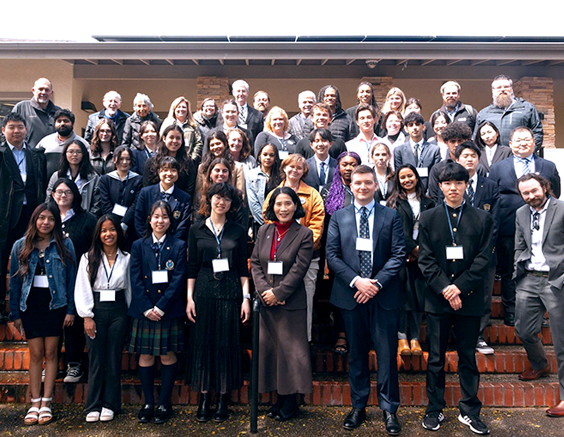
CIF Group on MIIS Campus
CIF participating schools conducted their projects based on this year’s topic “Advancing Nuclear Disarmament and Nonproliferation Through Youth Education.” This topic encouraged the students to get involved with their respective schools and introduce this relatively unknown set of concepts to their peers. They incorporated their interests for artwork, film making, and games in their educational projects in order to get more students of their age interested in nuclear disarmament and nonproliferation. The students not only stepped up as leaders in the local schools but also passed on the passion that they developed for these issues to their peers. The Conference not only gave students a chance to share their presentations but also to collaborate in small groups to create short-term and long-term action plans to achieve a world free of nuclear weapons.
The Conference also enabled CIF to further enhance its collaboration with the the Bread Loaf Teacher Network (BLTN) and the the Bread Loaf Next Generation Leadership Network. These two high school students-focused educational programs under the Middlebury Community shared many common goals. Therefore, we are thrilled to expand and deepen this collaboration. This way, CIF can engage more diverse groups of students while giving BLTN/NextGen students a chance to study nuclear disarmament issues. This was made possible by the Middlebury Provost Office’s Strategic Initiative Fund. Thanks to this we were able to engage Aiken High School, Atherton High School, Julia R. Masterman Laboratory and Demonstration School, and Middlebury Union High School in the CIF project.
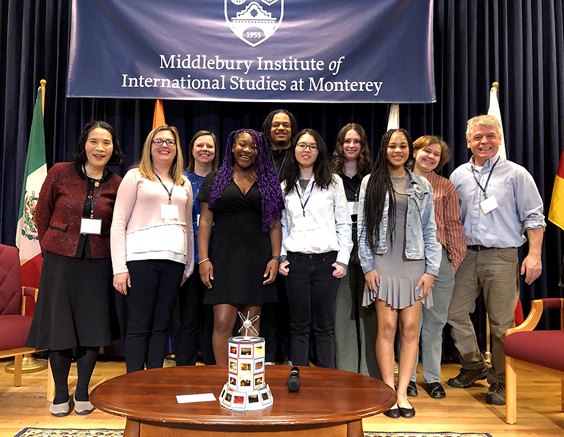
Bread Loaf Teacher Network/Next Gen students joins CIF!
Opening
The CIF Conference officially commenced on April 5th with opening remarks by Emcees from Carmel High School, Ryan Jalili and Marcus Michie. The Emcees introduced the seven schools from the United States and five schools from Japan, who made the trip all the way to Monterey. Also noteworthy was this was the first time that Carmel High School officially joined CIF, reflecting the success of our long-term efforts to engage more local high schools.
These introductions were followed by opening remarks of CIF’s Senior Project Manager, Masako Toki. She stressed the importance of youth education in making progress toward nuclear disarmament. Thereafter, Dr. William Potter, Founding Director of CNS, welcomed this year’s participants. He highlighted the mission of CNS and the role that youth can play in this turbulent world. The CIF was fortunate to welcome an inspiring keynote speaker, Henrik Dale, from the United Nations (UN). Dale is an Associate Political Affairs Officer in the Regional Disarmament, Information and Outreach Branch at the United Nations Office for Disarmament Affairs (UNODA), focusing on youth education, empowerment, engagement and outreach. During his speech titled “How to Meaningfully Engage, Educate and Empower Youth for Disarmament,” he explained the role that the UN plays in getting youth involved in disarmament activities. He urged the young students to go beyond what previous generations have done and tackle the issues that the world faces today.
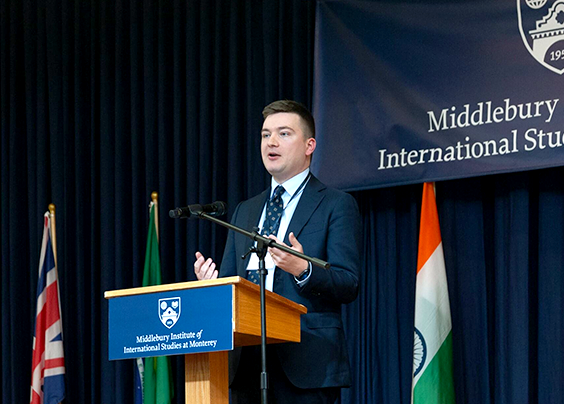
Mr. Henrik Dale, UN Office for Disarmament Affairs giving keynote speech
Henrik Dale took out the time to answer many students’ questions during the question-and-answer session after his speech. He answered their questions about UN’s activities and how students can get involved in them.
Students Presentations’ Highlights
The Conference featured students presentations on this year’s topic. The presentation touched on wide-ranging nuclear issues the world faces today. Each school presented creative and novel ideas to tackle nuclear issues.
Choate Rosemary Hall kicked off the student presentations with its project titled From Doomsday Clock to Effective Activism. They presented a screening of a film the students completely created by themselves. The film included impressive animation and original illustrations. After the screening, the students spoke about how powerful and effective films are to teach the youth about complex issues such as nuclear disarmament and nonproliferation.
The next school to present was Kansai Soka Senior High School from Osaka. Its presentation was entitled Nuclear Abolition Festival. The School had created the Nuclear Abolition Festival to make education about nuclear issues accessible and easy to digest. The Nuclear Abolition Festival appealed to other students because it made greater use of visual arts. The students found that this was an effective way to get their fellows to care about nuclear issues. The presenters said they will ensure the Festival continues next year, too.
Santa Cruz High School, the first time participant, and another local school, presented next with its presentation titled, Increasing Student Engagement Through the Intersection of Nuclear Disarmament and Climate Change. It spoke about youth activism for environmental issues and how to get youth involved in nuclear issues as well.
Next, a student from Nagasaki Higashi High School presented on Peace Education Through Active Learning: What I Want to Convey as a Citizen of Nagasaki. This student, who is a third-generation atomic bombing survivor and passionate about nuclear abolition, examined peace education in Japan and abroad. Japan has much more robust peace education in comparison to the United States, he noted. He determined that well-rounded and active learning is critical to improving the global standards of peace education.
Julia R. Masterman Laboratory and Demonstration School’s presentation was titled Nuclear Deterrence in India and Pakistan. These students shed light on the evolution of nuclear deterrence in South Asia and as to how it has affected strategic stability in the region.
The next presentation was entitled Medical Care with Emphasis on Mental Aftereffects of the Atomic Bomb, and delivered by a student from Hiroshima University High School. She spoke about her hometown and the experiences of Hibakusha (Atomic bombing survivors) in Hiroshima. Hibakusha not only face physical health issues but also invisible mental health issues that are in part due to the social discrimination that they face.
The CIF team of Rock University High School, from Janesville Wisconsin, presented on the creation of its creative board game with the title of Destiny or Devastation. The board game was seen as an engaging way for students to familiarize themselves with nuclear issues. This game used both the creative and research talents of the School’s entire CIF team.
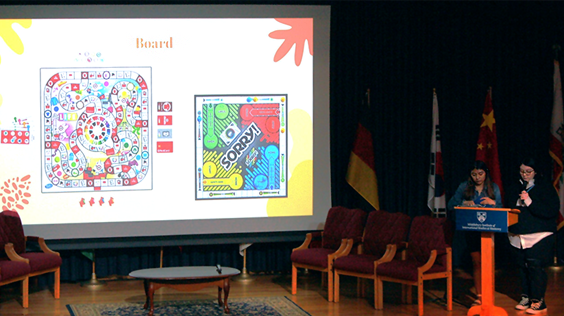
Students from Rock University High School introduce board game they created to promote disarmament education
Aiken High School’s presentation, Empowering Tomorrow’s Leaders: Exploring Nuclear Education with High School Students introduced CIF and nuclear issues to local schools. The Aiken Students stood out as young leaders in their local community and spoke up about the silence about nuclear issues in their hometown in South Carolina that houses the Savanah River Site that used to produce weapons-grade plutonium during the Cold War.
In the next presentation entitled Peace Education Consisting of 9 Processes, a student from Kwassui High School in Nagasaki, walked through the full process of peace education, including exchanges with students from various places and ages. She even traveled to the Marshall Islands to deepen her knowledge of peace education. She found that there was a wide range of ways to communicate peace including art, food, and more.
Atherton High School combined its CIF project, Women at the Center, with its Women’s Studies class at the School. The presenters lead a class at their school, which is centered on women’s role in nuclear issues. The students taught their peers how nuclear radiation harms women’s bodies, introduced women leaders in the nuclear disarmament field, and explained the role of film in nuclear education.
Carmel High School’s presentation was titled The Chosen Nation. They examined the role of Israel’s nuclear program in its national identity and its relations with other nations currently. Carmel High School’s CIF team presented in detail on Israel’s nuclear history, capabilities and nuclear strategy in today’s context. Given the School is located near MIIS and CNS, it invites nuclear experts to its students Public Policy Club to raise more awareness on this issue.
Soka Senior High School from Tokyo presented on the Role-play for Understanding: Educating Japanese Youth on the Complexity of Nuclear Disarmament. In order for students to get engaged with nuclear issues endangering the world today, Soka Senior High School’s team created a role-playing activity for students to get interested in nuclear issues. Another issue that the presentation discussed was the fact that students at their School had trouble understanding other countries’ views on nuclear issues. In the role-playing exercise, the students pretended to be Japan, the US, Russia and the International Campaign to Abolish Nuclear Weapons (ICAN), and this was effective in helping students understand different perspectives.
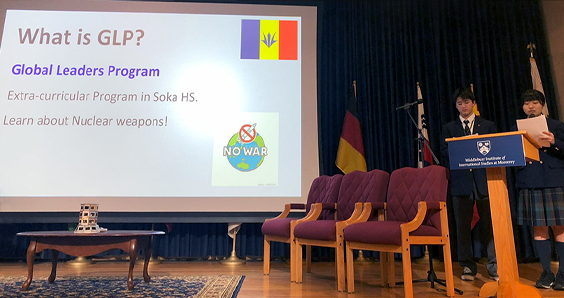
Soka Sr. High School Students introduce their school’s nuclear disarmament education
The Harker School presented on Regional Tensions in the South China Sea. It outlined China’s nuclear policy and role in international relations today as a nation with one of the largest nuclear arsenals. They examined China’s nuclear issues through the lenses of multiple theories in the field of international relations. Harker School students also wrote a comprehensive research paper on this topic.
To make the CIF conference more interactive, panel discussions among CIF high school students were conducted between the presentations. MIIS graduate students moderated the discussions. These panel discussions were a great way for presenters to explain their projects in greater details. The students were asked about their CIF experiences and what they gained from them. The students also shared the challenges that they encountered during their research, and how they overcame them. Students also shared what they wish to tell the peers of their generation.
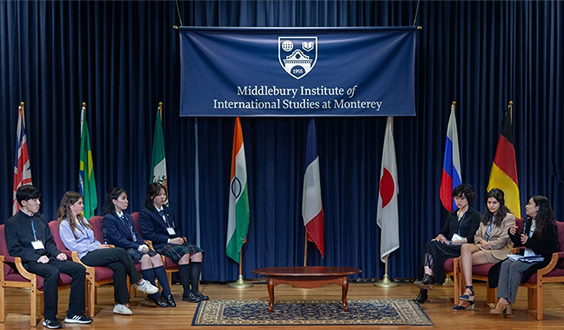
High School Students share their CIF experience at panel discussion moderated by MIIS graduate student
Small Group Discussions
As part of CIF efforts to give each student a chance to express their candid opinions, the Conference included small group discussions after the plenary session of the second day. The groups, led by MIIS’ student facilitators, created a group name, and developed short-term and long-term action plans for nuclear disarmament. The facilitators led the high school students and fostered their innovative ideas. After rich discussions in small groups, high school students had a chance to share their action plans for nuclear disarmament that can be taken by youth including high school students, as well as governing entities such as international organizations, national governments and local governments. Without exception, all the groups astutely recognized the significant roles that young people can play to promote nuclear disarmament. While there were various bright ideas presented by students, the underlying objective of each action plan was how to raise more awareness of nuclear dangers, the importance of nuclear disarmament, and how to educate younger generations on nuclear weapons – related issues.
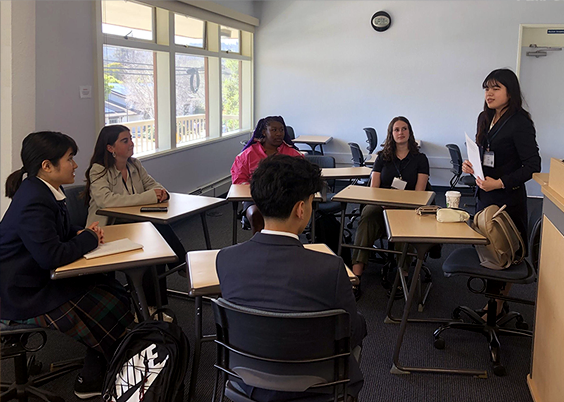
Small Group Discussion facilitated by graduate student
Their creative ideas in their action plans included improving America’s education system to raise awareness about the humanitarian impacts of nuclear weapons. Furthermore, they advocated sharing Hibakusha stories, promoting dialogue between nuclear weapon states and non-nuclear weapon states. Students stressed the importance of diverting funds from weapons programs to youth peace education and the importance of scholarships so that students have more opportunities to study abroad. They thought of ways to empower youth about these issues including organizing peaceful protests and promoting intercultural conferences such as the CIF Conference.
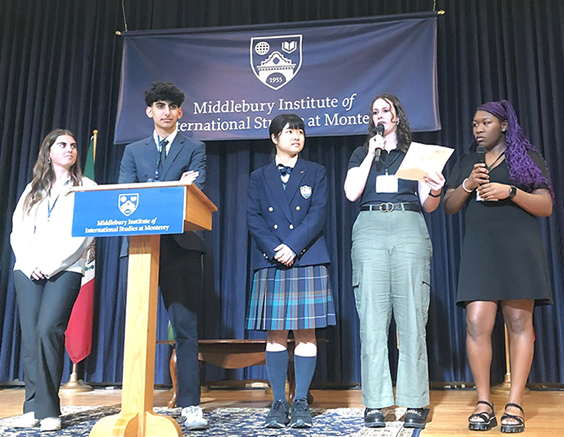
Each group presented their nuclear disarmament action plans after the small group discussion
Cross-cultural Activities
During the Conference, the students had plenty of opportunities for cross-cultural experiences. Before the first official day of the Conference, Japanese students from Tokyo, Osaka, Hiroshima and Nagasaki were given a tour of Monterey High School. The students bonded further during a lively game of Kahoot!, which quizzed them on geography, politics, nuclear disarmament, international disarmament treaties, pop culture and more. Moreover, Japanese students taught American students how to fold paper cranes, the symbol of peace. During their final day, the students all had an opportunity to visit Lovers Point for picnic which gave them the full Monterey experience. The Japanese students stayed with host families in Monterey to get fully immersed in American culture.
Conclusion
This year’s Conference topic, “Advancing Nonproliferation and Disarmament through Youth Education” cannot be more timely. We need more young people, especially high school students who are committed to enhancing peace and security as nuclear dangers are at the highest level since the end of the Cold War.
This Conference demonstrated that young people, such as these high school students, have tremendously important roles to play to make progress toward a world free of nuclear weapons. Moreover, cross-cultural activities have countless benefits for fostering international coalitions. The friendships they have cultivated during the Conference will inspire them to broaden their perspectives of the world. Not only did students have life changing experiences, but also acquired the leadership skills that they can use in their future. As the students all developed action plans to work toward a nuclear weapons free world, it is our hope that they are empowered to carry out their action plans.
The Conference was success as it brought together high school students in an enrichingly learning environment.
This could not have been possible without generous support from the Kathyrn Wasserman Davis Collaborative in Conflict Transformation Grant, the Tom and Sarah Pattison Fund, the SAGA Foundation, Middlebury Provost’s Academic Council, Mr. Gregg Wolpert and other private donors.

Carmel High School Students CIF Team at the Closing Ceremony
Students’ Testimonials
Students shared their perspectives and feedback about their experiences of participating in the Conference. Some of the notable ones are as follows.
“My experience at the CIF Spring Conference was amazing and it really allowed me to connect with students from around the country and Japan on a deeper level. It also allowed me to travel somewhere that I never thought I would be able to travel to and I got to see and experience lots of new things.”
“My weekend at CIF is one I’ll remember forever. I already know that the things that I’ve learned and the friendships I forged in a short 72 hours will stay with me for the rest of my life. With the CIF crowd, I was constantly laughing, talking, and discovering. Whether this was through discussions on our respective schools, ping-pong diplomacy, walking around Monterey, or teaching each other slang, we connected quickly and deeply. On the academic front, I made so many new connections about regional conflicts, climate change, and youth education. I will miss everyone at CIF dearly!”
“It was a great experience to work with similar minded peers from around the world and share our presentations. I loved getting to know them during downtime and having cultural exchanges. It was a bit of work getting the project done alongside schoolwork, but it was completely worth it. The resources provided, including lectures by graduate students, were helpful in informing me on the subject. It is a valuable experience that I hope can be expanded to include more schools and last longer so we can spread more awareness about this issue.”
“Thank you for providing us with such a wonderful opportunity to learn about nuclear issues and interact with students from around the world. I had such a wonderful experience in Monterey. I was surprised that American students study nuclear issues passionately and have their own action plans for nuclear disarmament. I respect their efforts. As a Japanese citizen, we should also think more about action plans towards nuclear disarmament not only to tell how tragic the use of nuclear weapons was but also the many other factors related to nuclear disarmament. As a young student, I believe that I should be able to come up with creative ideas on nuclear disarmament while learning from the tragedy of Hiroshima and Nagasaki.
In addition, I’m also very happy to make lots of friends! Among them, I became close to one of the American students, and we are keeping in touch with each other through Instagram. We introduced our school by taking videos and so on. I am grateful for all aspects of the CIF conference.”
“The action plans for nuclear disarmament presented by other high school students were very inspiring, and something I can incorporate when I think about my future career.”
List of Participating Schools
United States
Aiken High School, Aiken, SC
Atherton High School, Louisville, KY
Carmel High School, Carmel, CA
Choate Rosemary Hall, Wallingford, CT
The Harker School, San Jose, CA
Julia R. Masterman Laboratory and Demonstration School, Philadelphia, PA
Rock University High School, Janesville, WI
Santa Cruz High School, Santa Cruz, CA
Japan
Hiroshima University Senior High School, Hiroshima
Kansai Soka Senior High School, Osaka
Kwassui High School, Nagasaki
Nagasaki Higashi High School, Nagasaki
Soka Senior High School, Tokyo
Observer School
Monterey High School, Monterey, CA
Asynchronous participants
Middlebury Union High School, Middlebury VT,
Westridge School, Pasadena, CA
More Information
View the conference booklet for more details.
See students’ presentations!
See photo album!
